Organisational Behaviour Report: Burberry's Culture and Motivation
VerifiedAdded on 2022/12/30
|13
|3978
|79
Report
AI Summary
This report provides an in-depth analysis of organizational behaviour within the context of Burberry, a luxury fashion house. It examines how organizational culture, including power dynamics and politics, influences individual and team behaviour and performance, referencing Charles Handy's model of organizational culture. The report evaluates content and process theories of motivation, such as Maslow's Hierarchy of Needs, Herzberg's Two-Factor Theory, and Vroom's Expectancy Theory, and how these theories are applied to achieve organizational goals. Furthermore, it differentiates between effective and ineffective teams and applies organizational behaviour concepts to a given business situation. The analysis explores the impact of power, culture, and politics on employees, and how motivational techniques, such as rewarding employees and providing them with recognition can be used by the company. The report aims to provide insights into the management of workforce behavior and performance.
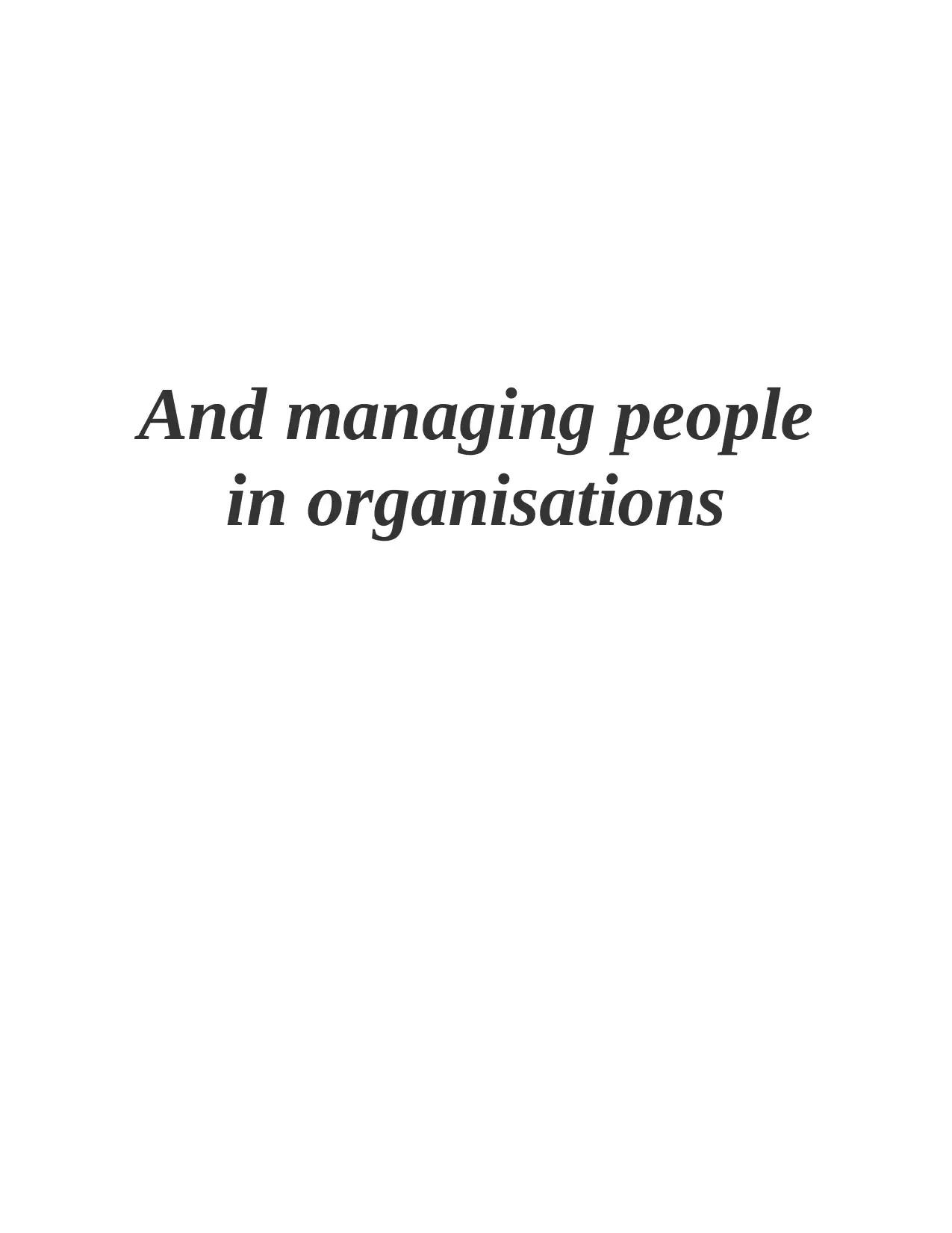
And managing people
in organisations
in organisations
Paraphrase This Document
Need a fresh take? Get an instant paraphrase of this document with our AI Paraphraser
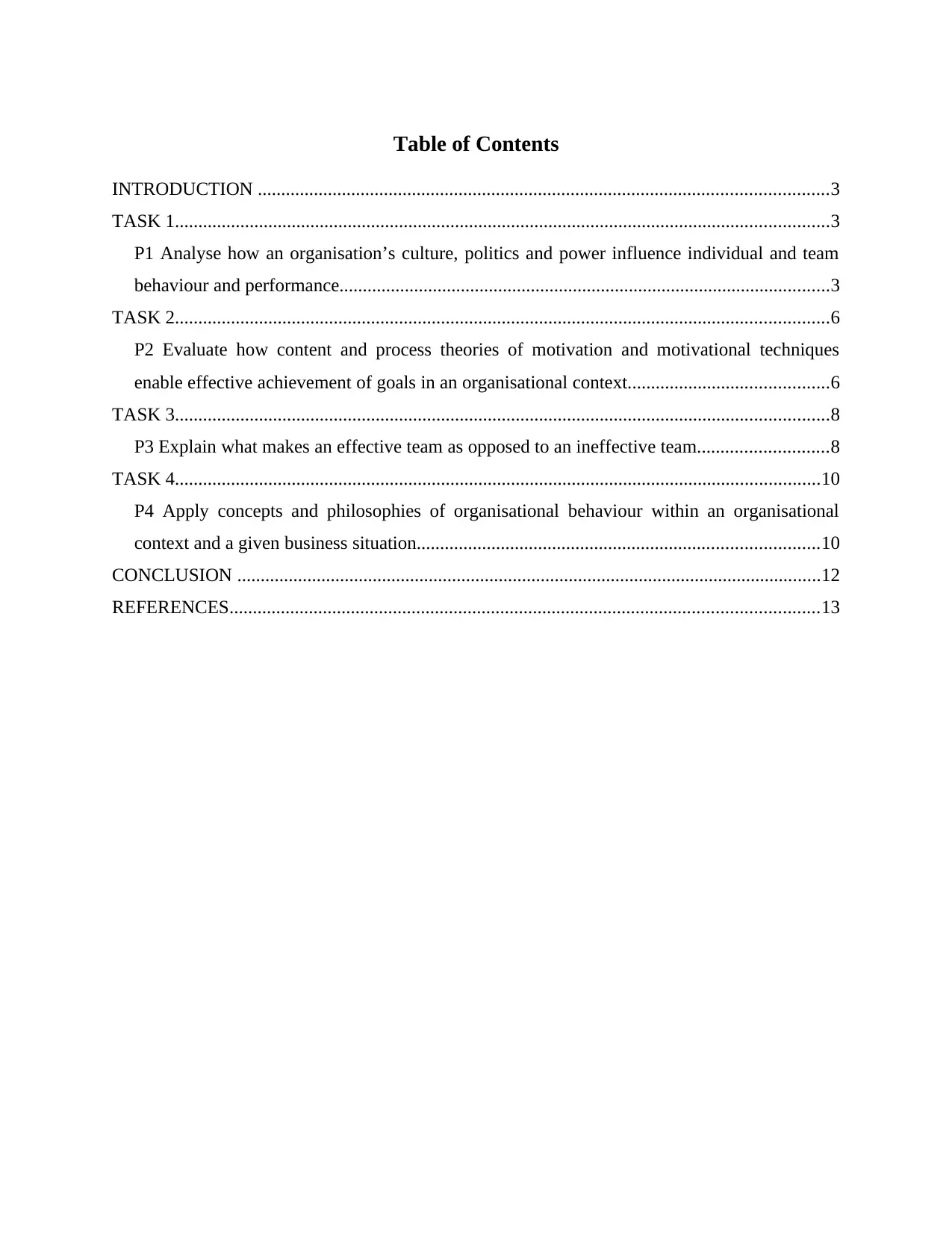
Table of Contents
INTRODUCTION ..........................................................................................................................3
TASK 1............................................................................................................................................3
P1 Analyse how an organisation’s culture, politics and power influence individual and team
behaviour and performance.........................................................................................................3
TASK 2............................................................................................................................................6
P2 Evaluate how content and process theories of motivation and motivational techniques
enable effective achievement of goals in an organisational context...........................................6
TASK 3............................................................................................................................................8
P3 Explain what makes an effective team as opposed to an ineffective team............................8
TASK 4..........................................................................................................................................10
P4 Apply concepts and philosophies of organisational behaviour within an organisational
context and a given business situation......................................................................................10
CONCLUSION .............................................................................................................................12
REFERENCES..............................................................................................................................13
INTRODUCTION ..........................................................................................................................3
TASK 1............................................................................................................................................3
P1 Analyse how an organisation’s culture, politics and power influence individual and team
behaviour and performance.........................................................................................................3
TASK 2............................................................................................................................................6
P2 Evaluate how content and process theories of motivation and motivational techniques
enable effective achievement of goals in an organisational context...........................................6
TASK 3............................................................................................................................................8
P3 Explain what makes an effective team as opposed to an ineffective team............................8
TASK 4..........................................................................................................................................10
P4 Apply concepts and philosophies of organisational behaviour within an organisational
context and a given business situation......................................................................................10
CONCLUSION .............................................................................................................................12
REFERENCES..............................................................................................................................13
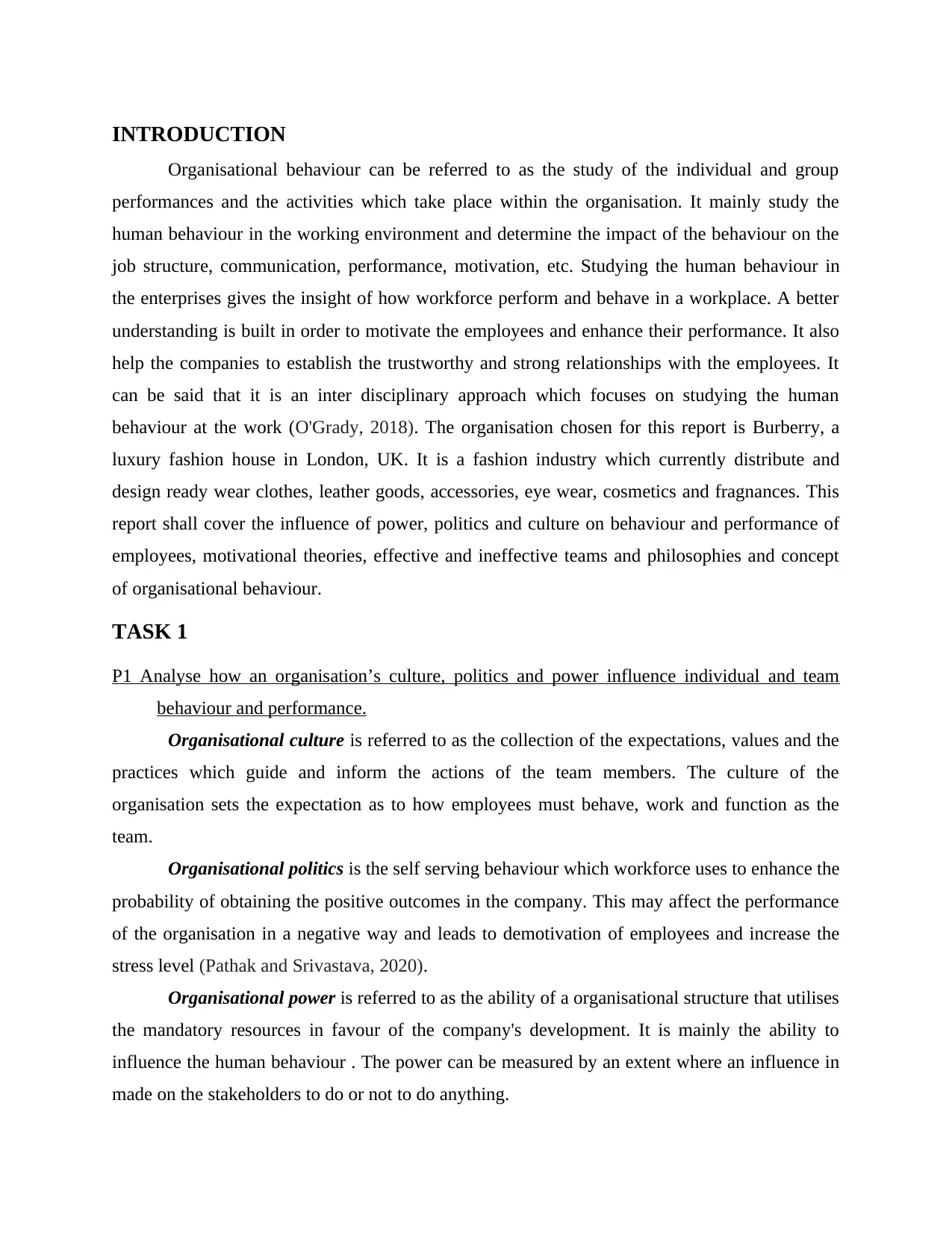
INTRODUCTION
Organisational behaviour can be referred to as the study of the individual and group
performances and the activities which take place within the organisation. It mainly study the
human behaviour in the working environment and determine the impact of the behaviour on the
job structure, communication, performance, motivation, etc. Studying the human behaviour in
the enterprises gives the insight of how workforce perform and behave in a workplace. A better
understanding is built in order to motivate the employees and enhance their performance. It also
help the companies to establish the trustworthy and strong relationships with the employees. It
can be said that it is an inter disciplinary approach which focuses on studying the human
behaviour at the work (O'Grady, 2018). The organisation chosen for this report is Burberry, a
luxury fashion house in London, UK. It is a fashion industry which currently distribute and
design ready wear clothes, leather goods, accessories, eye wear, cosmetics and fragnances. This
report shall cover the influence of power, politics and culture on behaviour and performance of
employees, motivational theories, effective and ineffective teams and philosophies and concept
of organisational behaviour.
TASK 1
P1 Analyse how an organisation’s culture, politics and power influence individual and team
behaviour and performance.
Organisational culture is referred to as the collection of the expectations, values and the
practices which guide and inform the actions of the team members. The culture of the
organisation sets the expectation as to how employees must behave, work and function as the
team.
Organisational politics is the self serving behaviour which workforce uses to enhance the
probability of obtaining the positive outcomes in the company. This may affect the performance
of the organisation in a negative way and leads to demotivation of employees and increase the
stress level (Pathak and Srivastava, 2020).
Organisational power is referred to as the ability of a organisational structure that utilises
the mandatory resources in favour of the company's development. It is mainly the ability to
influence the human behaviour . The power can be measured by an extent where an influence in
made on the stakeholders to do or not to do anything.
Organisational behaviour can be referred to as the study of the individual and group
performances and the activities which take place within the organisation. It mainly study the
human behaviour in the working environment and determine the impact of the behaviour on the
job structure, communication, performance, motivation, etc. Studying the human behaviour in
the enterprises gives the insight of how workforce perform and behave in a workplace. A better
understanding is built in order to motivate the employees and enhance their performance. It also
help the companies to establish the trustworthy and strong relationships with the employees. It
can be said that it is an inter disciplinary approach which focuses on studying the human
behaviour at the work (O'Grady, 2018). The organisation chosen for this report is Burberry, a
luxury fashion house in London, UK. It is a fashion industry which currently distribute and
design ready wear clothes, leather goods, accessories, eye wear, cosmetics and fragnances. This
report shall cover the influence of power, politics and culture on behaviour and performance of
employees, motivational theories, effective and ineffective teams and philosophies and concept
of organisational behaviour.
TASK 1
P1 Analyse how an organisation’s culture, politics and power influence individual and team
behaviour and performance.
Organisational culture is referred to as the collection of the expectations, values and the
practices which guide and inform the actions of the team members. The culture of the
organisation sets the expectation as to how employees must behave, work and function as the
team.
Organisational politics is the self serving behaviour which workforce uses to enhance the
probability of obtaining the positive outcomes in the company. This may affect the performance
of the organisation in a negative way and leads to demotivation of employees and increase the
stress level (Pathak and Srivastava, 2020).
Organisational power is referred to as the ability of a organisational structure that utilises
the mandatory resources in favour of the company's development. It is mainly the ability to
influence the human behaviour . The power can be measured by an extent where an influence in
made on the stakeholders to do or not to do anything.
⊘ This is a preview!⊘
Do you want full access?
Subscribe today to unlock all pages.

Trusted by 1+ million students worldwide
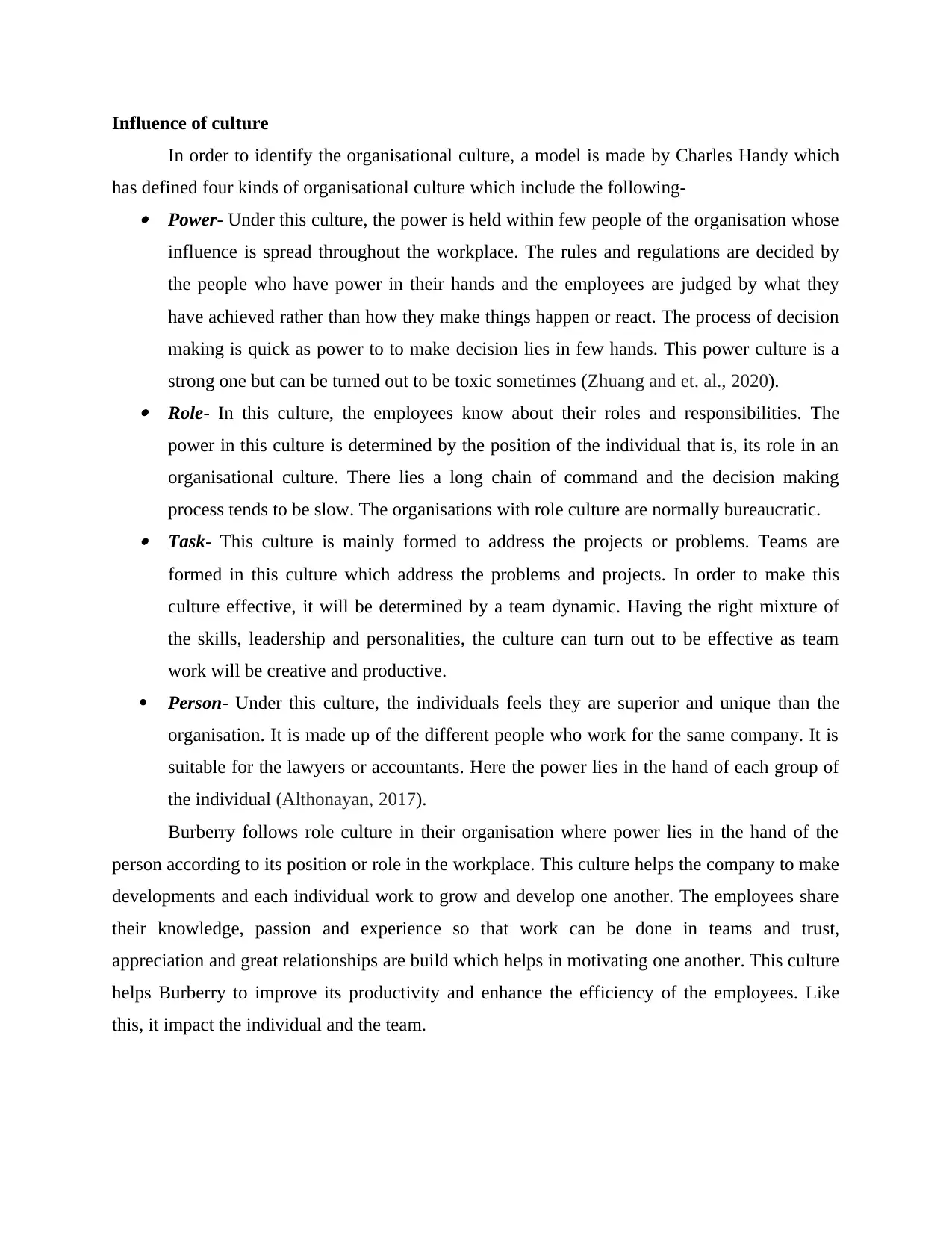
Influence of culture
In order to identify the organisational culture, a model is made by Charles Handy which
has defined four kinds of organisational culture which include the following- Power- Under this culture, the power is held within few people of the organisation whose
influence is spread throughout the workplace. The rules and regulations are decided by
the people who have power in their hands and the employees are judged by what they
have achieved rather than how they make things happen or react. The process of decision
making is quick as power to to make decision lies in few hands. This power culture is a
strong one but can be turned out to be toxic sometimes (Zhuang and et. al., 2020). Role- In this culture, the employees know about their roles and responsibilities. The
power in this culture is determined by the position of the individual that is, its role in an
organisational culture. There lies a long chain of command and the decision making
process tends to be slow. The organisations with role culture are normally bureaucratic. Task- This culture is mainly formed to address the projects or problems. Teams are
formed in this culture which address the problems and projects. In order to make this
culture effective, it will be determined by a team dynamic. Having the right mixture of
the skills, leadership and personalities, the culture can turn out to be effective as team
work will be creative and productive.
Person- Under this culture, the individuals feels they are superior and unique than the
organisation. It is made up of the different people who work for the same company. It is
suitable for the lawyers or accountants. Here the power lies in the hand of each group of
the individual (Althonayan, 2017).
Burberry follows role culture in their organisation where power lies in the hand of the
person according to its position or role in the workplace. This culture helps the company to make
developments and each individual work to grow and develop one another. The employees share
their knowledge, passion and experience so that work can be done in teams and trust,
appreciation and great relationships are build which helps in motivating one another. This culture
helps Burberry to improve its productivity and enhance the efficiency of the employees. Like
this, it impact the individual and the team.
In order to identify the organisational culture, a model is made by Charles Handy which
has defined four kinds of organisational culture which include the following- Power- Under this culture, the power is held within few people of the organisation whose
influence is spread throughout the workplace. The rules and regulations are decided by
the people who have power in their hands and the employees are judged by what they
have achieved rather than how they make things happen or react. The process of decision
making is quick as power to to make decision lies in few hands. This power culture is a
strong one but can be turned out to be toxic sometimes (Zhuang and et. al., 2020). Role- In this culture, the employees know about their roles and responsibilities. The
power in this culture is determined by the position of the individual that is, its role in an
organisational culture. There lies a long chain of command and the decision making
process tends to be slow. The organisations with role culture are normally bureaucratic. Task- This culture is mainly formed to address the projects or problems. Teams are
formed in this culture which address the problems and projects. In order to make this
culture effective, it will be determined by a team dynamic. Having the right mixture of
the skills, leadership and personalities, the culture can turn out to be effective as team
work will be creative and productive.
Person- Under this culture, the individuals feels they are superior and unique than the
organisation. It is made up of the different people who work for the same company. It is
suitable for the lawyers or accountants. Here the power lies in the hand of each group of
the individual (Althonayan, 2017).
Burberry follows role culture in their organisation where power lies in the hand of the
person according to its position or role in the workplace. This culture helps the company to make
developments and each individual work to grow and develop one another. The employees share
their knowledge, passion and experience so that work can be done in teams and trust,
appreciation and great relationships are build which helps in motivating one another. This culture
helps Burberry to improve its productivity and enhance the efficiency of the employees. Like
this, it impact the individual and the team.
Paraphrase This Document
Need a fresh take? Get an instant paraphrase of this document with our AI Paraphraser
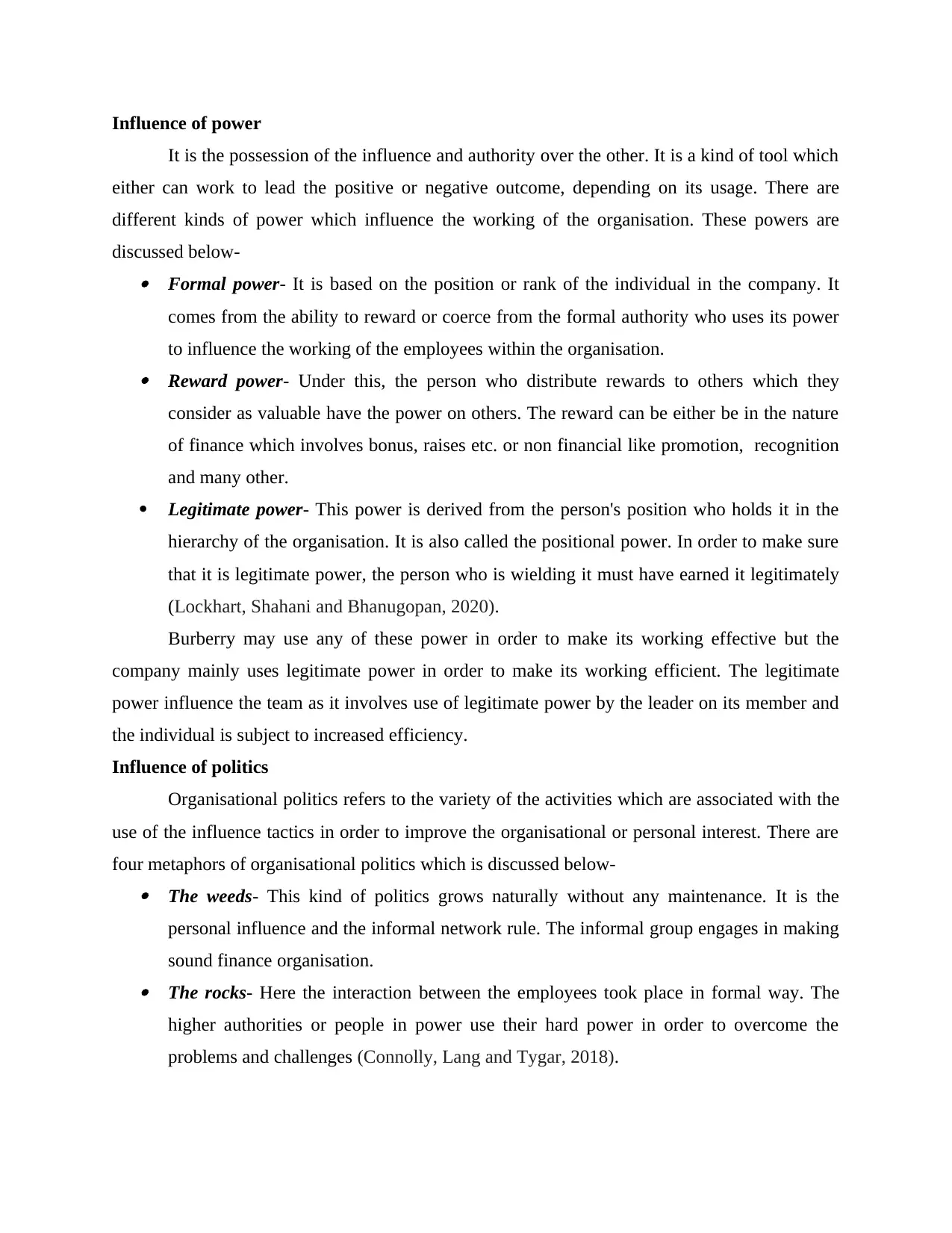
Influence of power
It is the possession of the influence and authority over the other. It is a kind of tool which
either can work to lead the positive or negative outcome, depending on its usage. There are
different kinds of power which influence the working of the organisation. These powers are
discussed below- Formal power- It is based on the position or rank of the individual in the company. It
comes from the ability to reward or coerce from the formal authority who uses its power
to influence the working of the employees within the organisation. Reward power- Under this, the person who distribute rewards to others which they
consider as valuable have the power on others. The reward can be either be in the nature
of finance which involves bonus, raises etc. or non financial like promotion, recognition
and many other.
Legitimate power- This power is derived from the person's position who holds it in the
hierarchy of the organisation. It is also called the positional power. In order to make sure
that it is legitimate power, the person who is wielding it must have earned it legitimately
(Lockhart, Shahani and Bhanugopan, 2020).
Burberry may use any of these power in order to make its working effective but the
company mainly uses legitimate power in order to make its working efficient. The legitimate
power influence the team as it involves use of legitimate power by the leader on its member and
the individual is subject to increased efficiency.
Influence of politics
Organisational politics refers to the variety of the activities which are associated with the
use of the influence tactics in order to improve the organisational or personal interest. There are
four metaphors of organisational politics which is discussed below- The weeds- This kind of politics grows naturally without any maintenance. It is the
personal influence and the informal network rule. The informal group engages in making
sound finance organisation. The rocks- Here the interaction between the employees took place in formal way. The
higher authorities or people in power use their hard power in order to overcome the
problems and challenges (Connolly, Lang and Tygar, 2018).
It is the possession of the influence and authority over the other. It is a kind of tool which
either can work to lead the positive or negative outcome, depending on its usage. There are
different kinds of power which influence the working of the organisation. These powers are
discussed below- Formal power- It is based on the position or rank of the individual in the company. It
comes from the ability to reward or coerce from the formal authority who uses its power
to influence the working of the employees within the organisation. Reward power- Under this, the person who distribute rewards to others which they
consider as valuable have the power on others. The reward can be either be in the nature
of finance which involves bonus, raises etc. or non financial like promotion, recognition
and many other.
Legitimate power- This power is derived from the person's position who holds it in the
hierarchy of the organisation. It is also called the positional power. In order to make sure
that it is legitimate power, the person who is wielding it must have earned it legitimately
(Lockhart, Shahani and Bhanugopan, 2020).
Burberry may use any of these power in order to make its working effective but the
company mainly uses legitimate power in order to make its working efficient. The legitimate
power influence the team as it involves use of legitimate power by the leader on its member and
the individual is subject to increased efficiency.
Influence of politics
Organisational politics refers to the variety of the activities which are associated with the
use of the influence tactics in order to improve the organisational or personal interest. There are
four metaphors of organisational politics which is discussed below- The weeds- This kind of politics grows naturally without any maintenance. It is the
personal influence and the informal network rule. The informal group engages in making
sound finance organisation. The rocks- Here the interaction between the employees took place in formal way. The
higher authorities or people in power use their hard power in order to overcome the
problems and challenges (Connolly, Lang and Tygar, 2018).
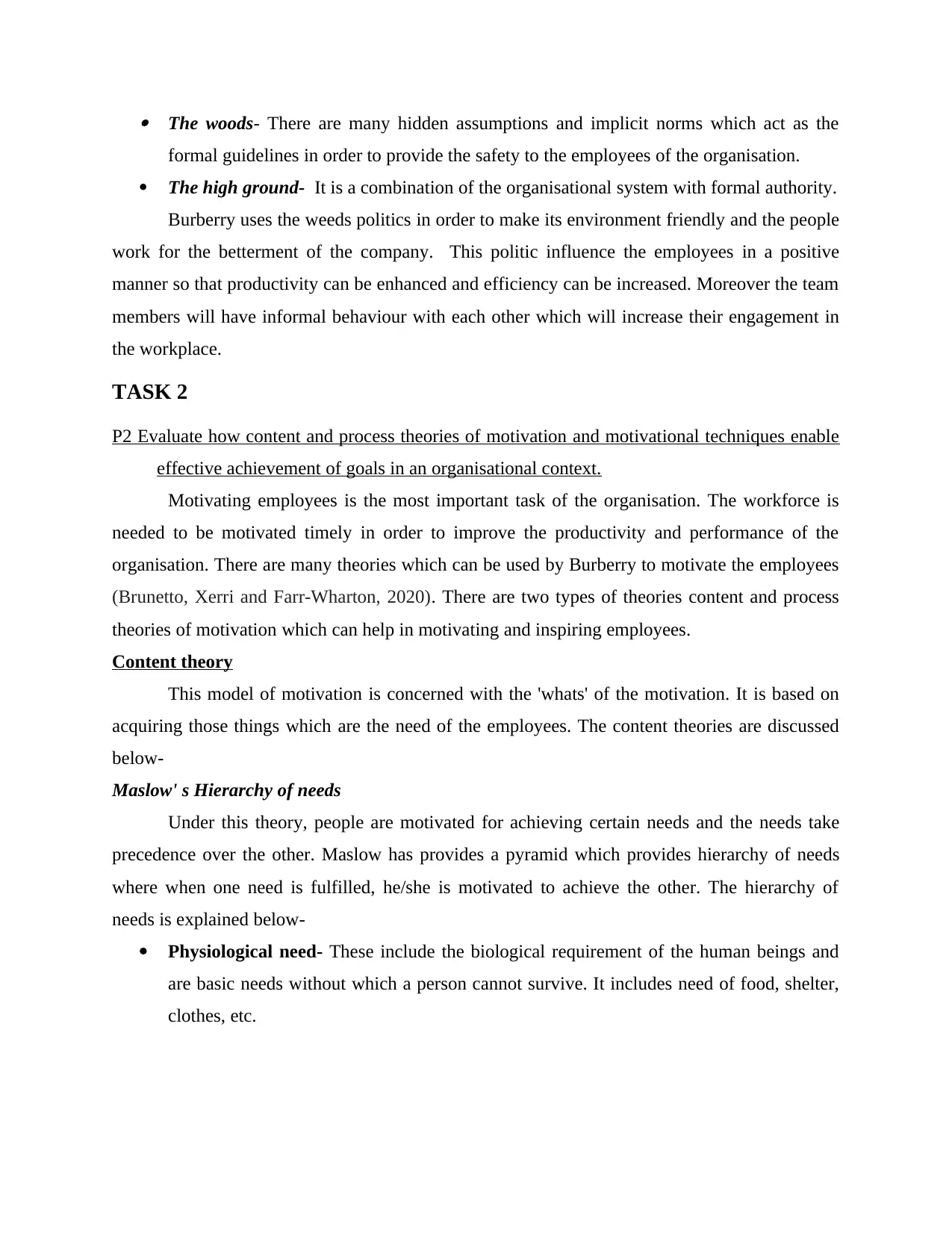
The woods- There are many hidden assumptions and implicit norms which act as the
formal guidelines in order to provide the safety to the employees of the organisation.
The high ground- It is a combination of the organisational system with formal authority.
Burberry uses the weeds politics in order to make its environment friendly and the people
work for the betterment of the company. This politic influence the employees in a positive
manner so that productivity can be enhanced and efficiency can be increased. Moreover the team
members will have informal behaviour with each other which will increase their engagement in
the workplace.
TASK 2
P2 Evaluate how content and process theories of motivation and motivational techniques enable
effective achievement of goals in an organisational context.
Motivating employees is the most important task of the organisation. The workforce is
needed to be motivated timely in order to improve the productivity and performance of the
organisation. There are many theories which can be used by Burberry to motivate the employees
(Brunetto, Xerri and Farr‐Wharton, 2020). There are two types of theories content and process
theories of motivation which can help in motivating and inspiring employees.
Content theory
This model of motivation is concerned with the 'whats' of the motivation. It is based on
acquiring those things which are the need of the employees. The content theories are discussed
below-
Maslow' s Hierarchy of needs
Under this theory, people are motivated for achieving certain needs and the needs take
precedence over the other. Maslow has provides a pyramid which provides hierarchy of needs
where when one need is fulfilled, he/she is motivated to achieve the other. The hierarchy of
needs is explained below-
Physiological need- These include the biological requirement of the human beings and
are basic needs without which a person cannot survive. It includes need of food, shelter,
clothes, etc.
formal guidelines in order to provide the safety to the employees of the organisation.
The high ground- It is a combination of the organisational system with formal authority.
Burberry uses the weeds politics in order to make its environment friendly and the people
work for the betterment of the company. This politic influence the employees in a positive
manner so that productivity can be enhanced and efficiency can be increased. Moreover the team
members will have informal behaviour with each other which will increase their engagement in
the workplace.
TASK 2
P2 Evaluate how content and process theories of motivation and motivational techniques enable
effective achievement of goals in an organisational context.
Motivating employees is the most important task of the organisation. The workforce is
needed to be motivated timely in order to improve the productivity and performance of the
organisation. There are many theories which can be used by Burberry to motivate the employees
(Brunetto, Xerri and Farr‐Wharton, 2020). There are two types of theories content and process
theories of motivation which can help in motivating and inspiring employees.
Content theory
This model of motivation is concerned with the 'whats' of the motivation. It is based on
acquiring those things which are the need of the employees. The content theories are discussed
below-
Maslow' s Hierarchy of needs
Under this theory, people are motivated for achieving certain needs and the needs take
precedence over the other. Maslow has provides a pyramid which provides hierarchy of needs
where when one need is fulfilled, he/she is motivated to achieve the other. The hierarchy of
needs is explained below-
Physiological need- These include the biological requirement of the human beings and
are basic needs without which a person cannot survive. It includes need of food, shelter,
clothes, etc.
⊘ This is a preview!⊘
Do you want full access?
Subscribe today to unlock all pages.

Trusted by 1+ million students worldwide
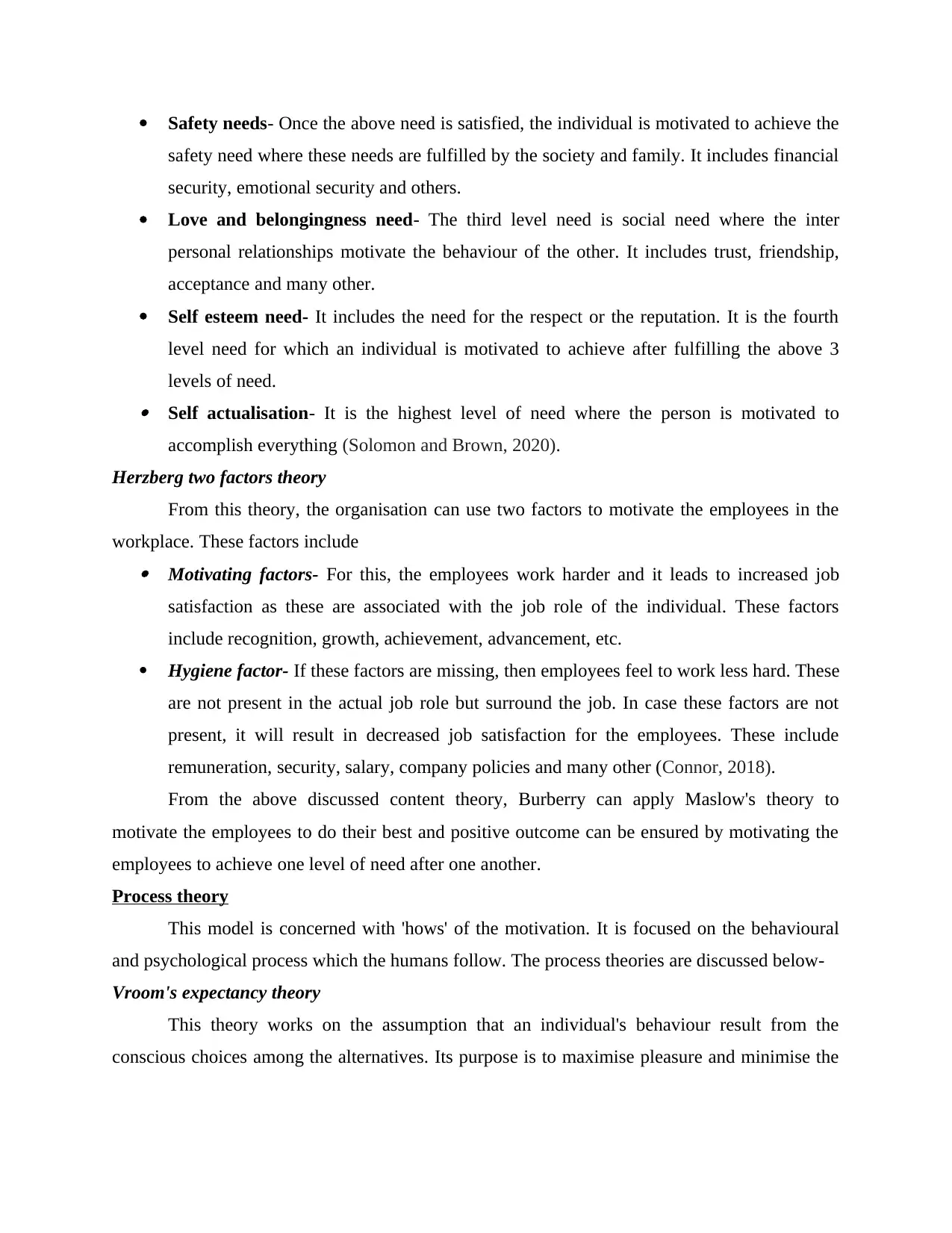
Safety needs- Once the above need is satisfied, the individual is motivated to achieve the
safety need where these needs are fulfilled by the society and family. It includes financial
security, emotional security and others.
Love and belongingness need- The third level need is social need where the inter
personal relationships motivate the behaviour of the other. It includes trust, friendship,
acceptance and many other.
Self esteem need- It includes the need for the respect or the reputation. It is the fourth
level need for which an individual is motivated to achieve after fulfilling the above 3
levels of need. Self actualisation- It is the highest level of need where the person is motivated to
accomplish everything (Solomon and Brown, 2020).
Herzberg two factors theory
From this theory, the organisation can use two factors to motivate the employees in the
workplace. These factors include Motivating factors- For this, the employees work harder and it leads to increased job
satisfaction as these are associated with the job role of the individual. These factors
include recognition, growth, achievement, advancement, etc.
Hygiene factor- If these factors are missing, then employees feel to work less hard. These
are not present in the actual job role but surround the job. In case these factors are not
present, it will result in decreased job satisfaction for the employees. These include
remuneration, security, salary, company policies and many other (Connor, 2018).
From the above discussed content theory, Burberry can apply Maslow's theory to
motivate the employees to do their best and positive outcome can be ensured by motivating the
employees to achieve one level of need after one another.
Process theory
This model is concerned with 'hows' of the motivation. It is focused on the behavioural
and psychological process which the humans follow. The process theories are discussed below-
Vroom's expectancy theory
This theory works on the assumption that an individual's behaviour result from the
conscious choices among the alternatives. Its purpose is to maximise pleasure and minimise the
safety need where these needs are fulfilled by the society and family. It includes financial
security, emotional security and others.
Love and belongingness need- The third level need is social need where the inter
personal relationships motivate the behaviour of the other. It includes trust, friendship,
acceptance and many other.
Self esteem need- It includes the need for the respect or the reputation. It is the fourth
level need for which an individual is motivated to achieve after fulfilling the above 3
levels of need. Self actualisation- It is the highest level of need where the person is motivated to
accomplish everything (Solomon and Brown, 2020).
Herzberg two factors theory
From this theory, the organisation can use two factors to motivate the employees in the
workplace. These factors include Motivating factors- For this, the employees work harder and it leads to increased job
satisfaction as these are associated with the job role of the individual. These factors
include recognition, growth, achievement, advancement, etc.
Hygiene factor- If these factors are missing, then employees feel to work less hard. These
are not present in the actual job role but surround the job. In case these factors are not
present, it will result in decreased job satisfaction for the employees. These include
remuneration, security, salary, company policies and many other (Connor, 2018).
From the above discussed content theory, Burberry can apply Maslow's theory to
motivate the employees to do their best and positive outcome can be ensured by motivating the
employees to achieve one level of need after one another.
Process theory
This model is concerned with 'hows' of the motivation. It is focused on the behavioural
and psychological process which the humans follow. The process theories are discussed below-
Vroom's expectancy theory
This theory works on the assumption that an individual's behaviour result from the
conscious choices among the alternatives. Its purpose is to maximise pleasure and minimise the
Paraphrase This Document
Need a fresh take? Get an instant paraphrase of this document with our AI Paraphraser
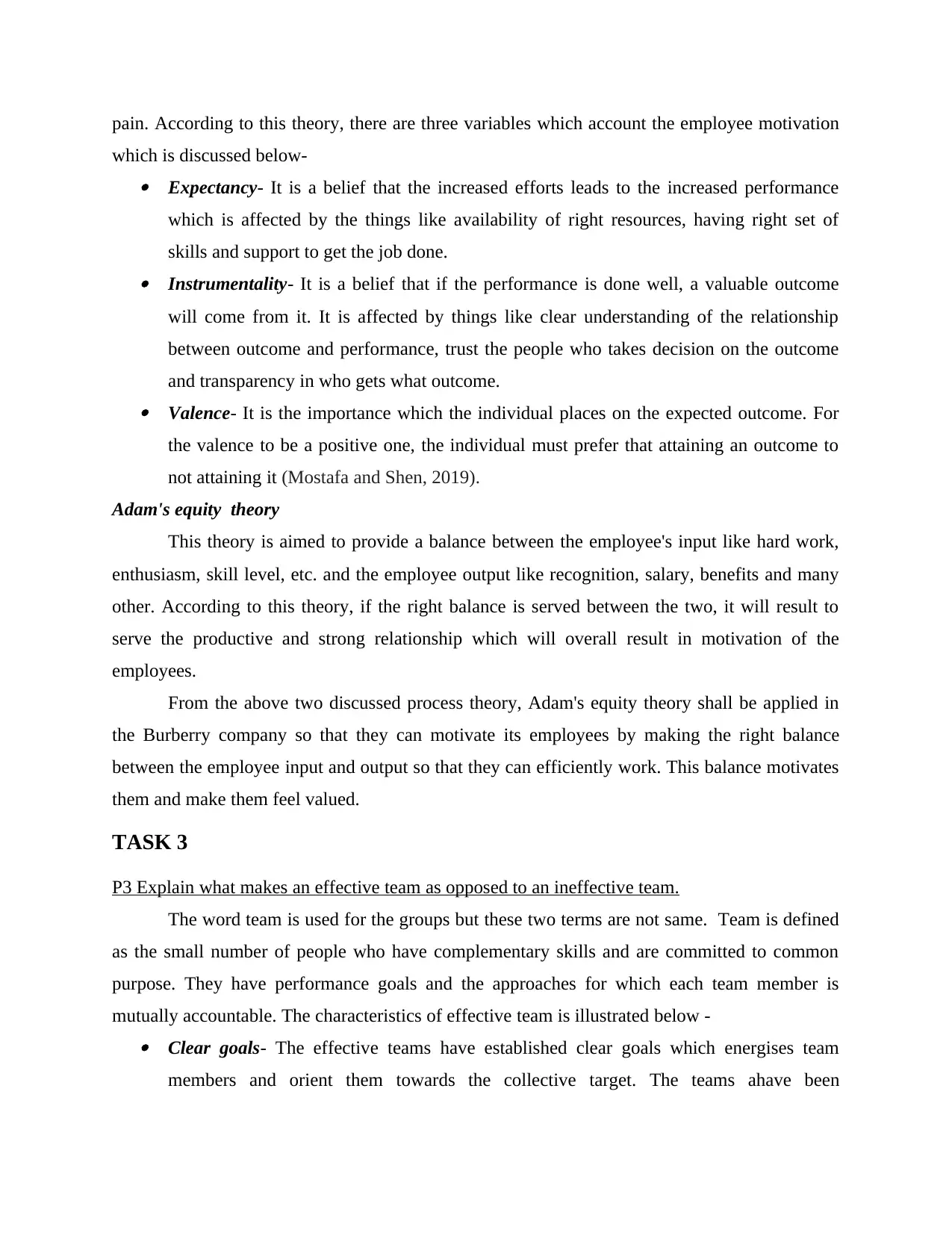
pain. According to this theory, there are three variables which account the employee motivation
which is discussed below- Expectancy- It is a belief that the increased efforts leads to the increased performance
which is affected by the things like availability of right resources, having right set of
skills and support to get the job done. Instrumentality- It is a belief that if the performance is done well, a valuable outcome
will come from it. It is affected by things like clear understanding of the relationship
between outcome and performance, trust the people who takes decision on the outcome
and transparency in who gets what outcome. Valence- It is the importance which the individual places on the expected outcome. For
the valence to be a positive one, the individual must prefer that attaining an outcome to
not attaining it (Mostafa and Shen, 2019).
Adam's equity theory
This theory is aimed to provide a balance between the employee's input like hard work,
enthusiasm, skill level, etc. and the employee output like recognition, salary, benefits and many
other. According to this theory, if the right balance is served between the two, it will result to
serve the productive and strong relationship which will overall result in motivation of the
employees.
From the above two discussed process theory, Adam's equity theory shall be applied in
the Burberry company so that they can motivate its employees by making the right balance
between the employee input and output so that they can efficiently work. This balance motivates
them and make them feel valued.
TASK 3
P3 Explain what makes an effective team as opposed to an ineffective team.
The word team is used for the groups but these two terms are not same. Team is defined
as the small number of people who have complementary skills and are committed to common
purpose. They have performance goals and the approaches for which each team member is
mutually accountable. The characteristics of effective team is illustrated below - Clear goals- The effective teams have established clear goals which energises team
members and orient them towards the collective target. The teams ahave been
which is discussed below- Expectancy- It is a belief that the increased efforts leads to the increased performance
which is affected by the things like availability of right resources, having right set of
skills and support to get the job done. Instrumentality- It is a belief that if the performance is done well, a valuable outcome
will come from it. It is affected by things like clear understanding of the relationship
between outcome and performance, trust the people who takes decision on the outcome
and transparency in who gets what outcome. Valence- It is the importance which the individual places on the expected outcome. For
the valence to be a positive one, the individual must prefer that attaining an outcome to
not attaining it (Mostafa and Shen, 2019).
Adam's equity theory
This theory is aimed to provide a balance between the employee's input like hard work,
enthusiasm, skill level, etc. and the employee output like recognition, salary, benefits and many
other. According to this theory, if the right balance is served between the two, it will result to
serve the productive and strong relationship which will overall result in motivation of the
employees.
From the above two discussed process theory, Adam's equity theory shall be applied in
the Burberry company so that they can motivate its employees by making the right balance
between the employee input and output so that they can efficiently work. This balance motivates
them and make them feel valued.
TASK 3
P3 Explain what makes an effective team as opposed to an ineffective team.
The word team is used for the groups but these two terms are not same. Team is defined
as the small number of people who have complementary skills and are committed to common
purpose. They have performance goals and the approaches for which each team member is
mutually accountable. The characteristics of effective team is illustrated below - Clear goals- The effective teams have established clear goals which energises team
members and orient them towards the collective target. The teams ahave been
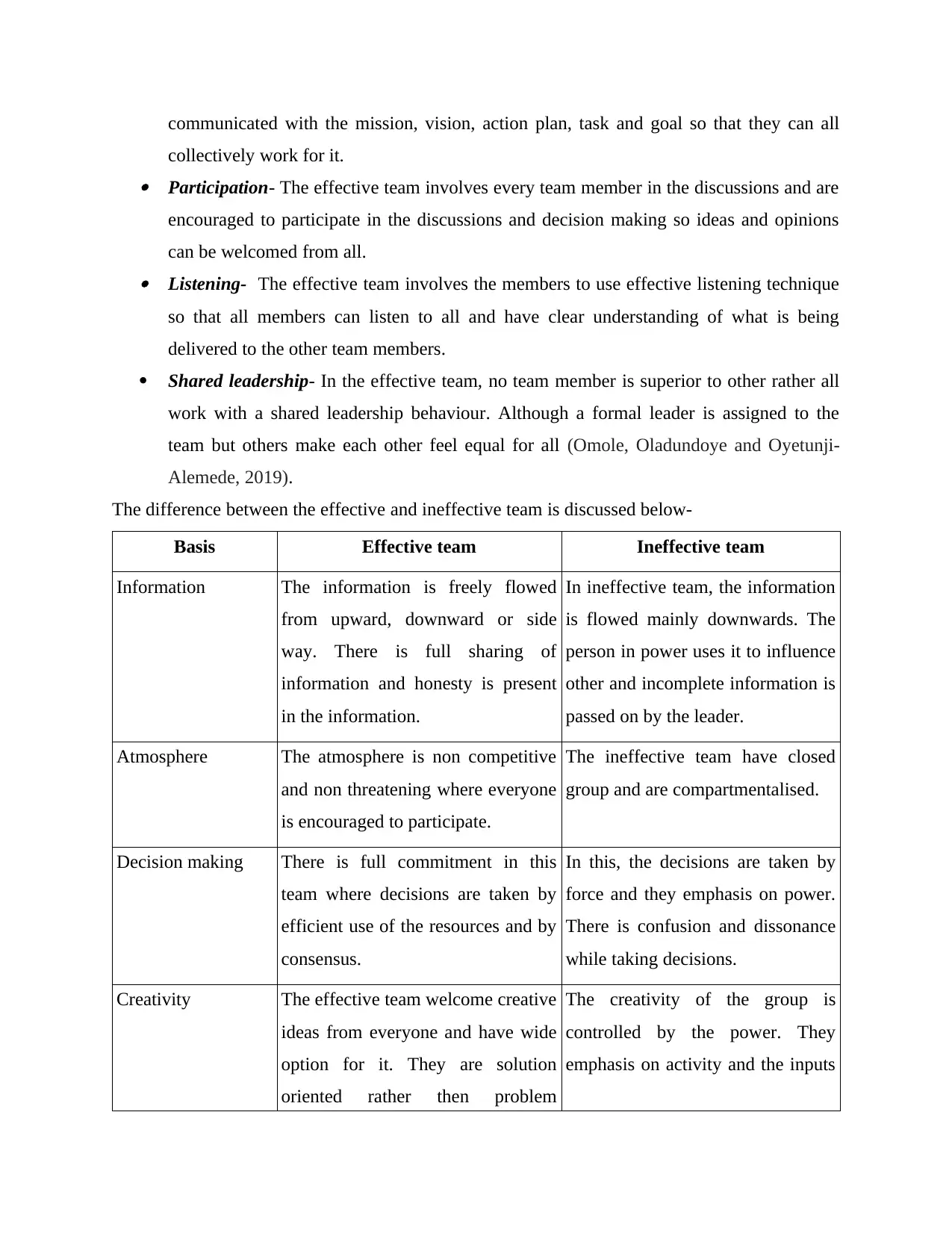
communicated with the mission, vision, action plan, task and goal so that they can all
collectively work for it. Participation- The effective team involves every team member in the discussions and are
encouraged to participate in the discussions and decision making so ideas and opinions
can be welcomed from all. Listening- The effective team involves the members to use effective listening technique
so that all members can listen to all and have clear understanding of what is being
delivered to the other team members.
Shared leadership- In the effective team, no team member is superior to other rather all
work with a shared leadership behaviour. Although a formal leader is assigned to the
team but others make each other feel equal for all (Omole, Oladundoye and Oyetunji-
Alemede, 2019).
The difference between the effective and ineffective team is discussed below-
Basis Effective team Ineffective team
Information The information is freely flowed
from upward, downward or side
way. There is full sharing of
information and honesty is present
in the information.
In ineffective team, the information
is flowed mainly downwards. The
person in power uses it to influence
other and incomplete information is
passed on by the leader.
Atmosphere The atmosphere is non competitive
and non threatening where everyone
is encouraged to participate.
The ineffective team have closed
group and are compartmentalised.
Decision making There is full commitment in this
team where decisions are taken by
efficient use of the resources and by
consensus.
In this, the decisions are taken by
force and they emphasis on power.
There is confusion and dissonance
while taking decisions.
Creativity The effective team welcome creative
ideas from everyone and have wide
option for it. They are solution
oriented rather then problem
The creativity of the group is
controlled by the power. They
emphasis on activity and the inputs
collectively work for it. Participation- The effective team involves every team member in the discussions and are
encouraged to participate in the discussions and decision making so ideas and opinions
can be welcomed from all. Listening- The effective team involves the members to use effective listening technique
so that all members can listen to all and have clear understanding of what is being
delivered to the other team members.
Shared leadership- In the effective team, no team member is superior to other rather all
work with a shared leadership behaviour. Although a formal leader is assigned to the
team but others make each other feel equal for all (Omole, Oladundoye and Oyetunji-
Alemede, 2019).
The difference between the effective and ineffective team is discussed below-
Basis Effective team Ineffective team
Information The information is freely flowed
from upward, downward or side
way. There is full sharing of
information and honesty is present
in the information.
In ineffective team, the information
is flowed mainly downwards. The
person in power uses it to influence
other and incomplete information is
passed on by the leader.
Atmosphere The atmosphere is non competitive
and non threatening where everyone
is encouraged to participate.
The ineffective team have closed
group and are compartmentalised.
Decision making There is full commitment in this
team where decisions are taken by
efficient use of the resources and by
consensus.
In this, the decisions are taken by
force and they emphasis on power.
There is confusion and dissonance
while taking decisions.
Creativity The effective team welcome creative
ideas from everyone and have wide
option for it. They are solution
oriented rather then problem
The creativity of the group is
controlled by the power. They
emphasis on activity and the inputs
⊘ This is a preview!⊘
Do you want full access?
Subscribe today to unlock all pages.

Trusted by 1+ million students worldwide
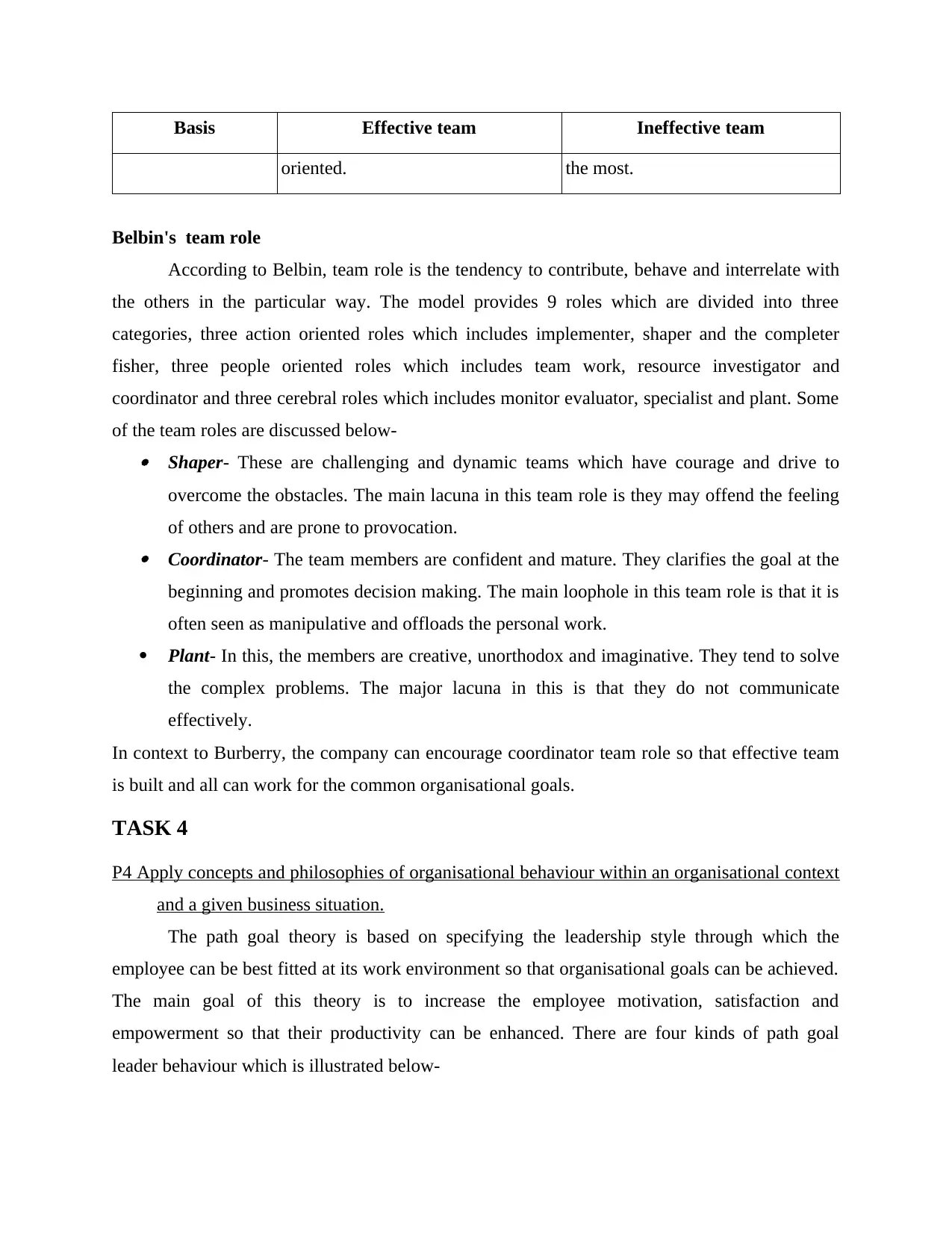
Basis Effective team Ineffective team
oriented. the most.
Belbin's team role
According to Belbin, team role is the tendency to contribute, behave and interrelate with
the others in the particular way. The model provides 9 roles which are divided into three
categories, three action oriented roles which includes implementer, shaper and the completer
fisher, three people oriented roles which includes team work, resource investigator and
coordinator and three cerebral roles which includes monitor evaluator, specialist and plant. Some
of the team roles are discussed below- Shaper- These are challenging and dynamic teams which have courage and drive to
overcome the obstacles. The main lacuna in this team role is they may offend the feeling
of others and are prone to provocation. Coordinator- The team members are confident and mature. They clarifies the goal at the
beginning and promotes decision making. The main loophole in this team role is that it is
often seen as manipulative and offloads the personal work.
Plant- In this, the members are creative, unorthodox and imaginative. They tend to solve
the complex problems. The major lacuna in this is that they do not communicate
effectively.
In context to Burberry, the company can encourage coordinator team role so that effective team
is built and all can work for the common organisational goals.
TASK 4
P4 Apply concepts and philosophies of organisational behaviour within an organisational context
and a given business situation.
The path goal theory is based on specifying the leadership style through which the
employee can be best fitted at its work environment so that organisational goals can be achieved.
The main goal of this theory is to increase the employee motivation, satisfaction and
empowerment so that their productivity can be enhanced. There are four kinds of path goal
leader behaviour which is illustrated below-
oriented. the most.
Belbin's team role
According to Belbin, team role is the tendency to contribute, behave and interrelate with
the others in the particular way. The model provides 9 roles which are divided into three
categories, three action oriented roles which includes implementer, shaper and the completer
fisher, three people oriented roles which includes team work, resource investigator and
coordinator and three cerebral roles which includes monitor evaluator, specialist and plant. Some
of the team roles are discussed below- Shaper- These are challenging and dynamic teams which have courage and drive to
overcome the obstacles. The main lacuna in this team role is they may offend the feeling
of others and are prone to provocation. Coordinator- The team members are confident and mature. They clarifies the goal at the
beginning and promotes decision making. The main loophole in this team role is that it is
often seen as manipulative and offloads the personal work.
Plant- In this, the members are creative, unorthodox and imaginative. They tend to solve
the complex problems. The major lacuna in this is that they do not communicate
effectively.
In context to Burberry, the company can encourage coordinator team role so that effective team
is built and all can work for the common organisational goals.
TASK 4
P4 Apply concepts and philosophies of organisational behaviour within an organisational context
and a given business situation.
The path goal theory is based on specifying the leadership style through which the
employee can be best fitted at its work environment so that organisational goals can be achieved.
The main goal of this theory is to increase the employee motivation, satisfaction and
empowerment so that their productivity can be enhanced. There are four kinds of path goal
leader behaviour which is illustrated below-
Paraphrase This Document
Need a fresh take? Get an instant paraphrase of this document with our AI Paraphraser
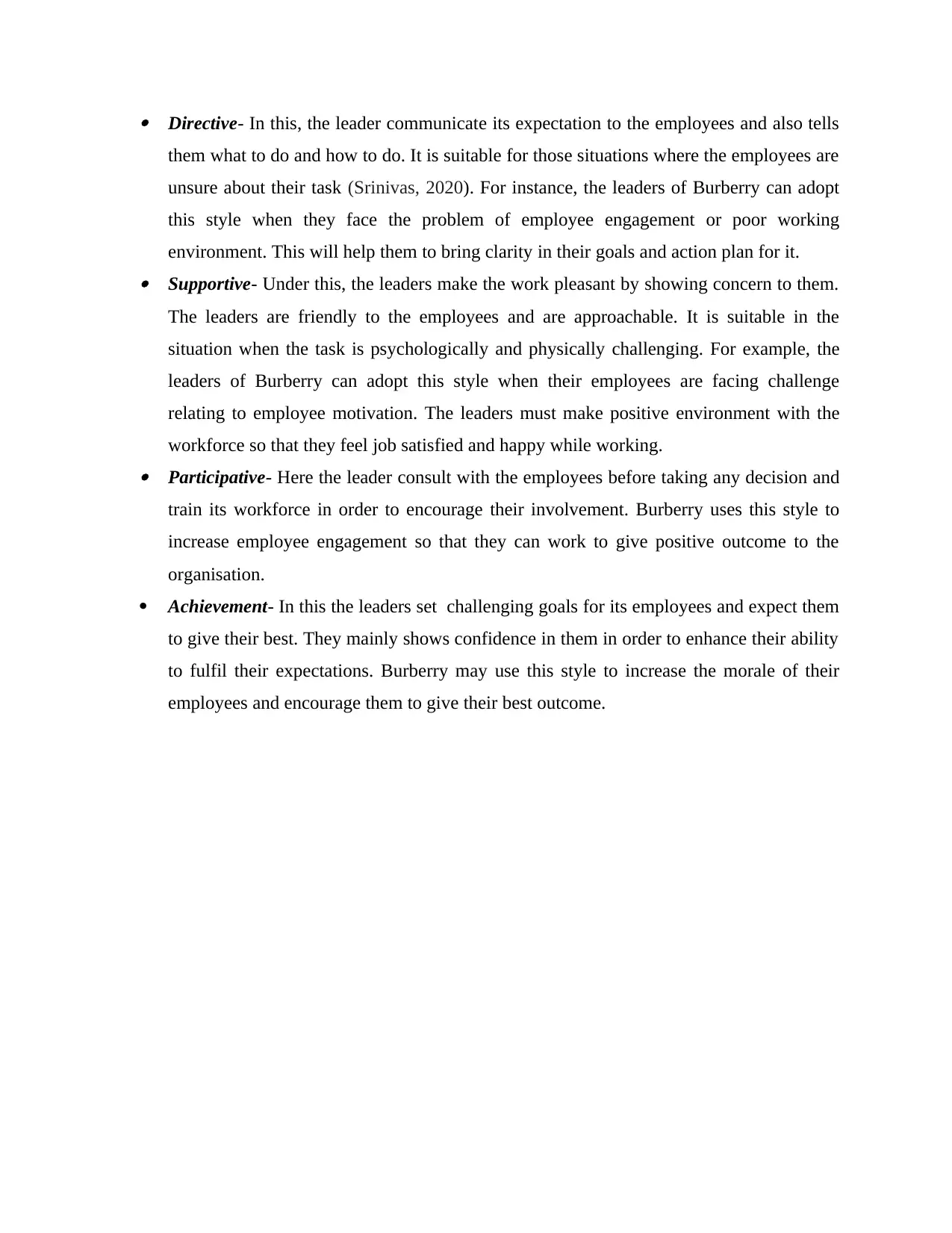
Directive- In this, the leader communicate its expectation to the employees and also tells
them what to do and how to do. It is suitable for those situations where the employees are
unsure about their task (Srinivas, 2020). For instance, the leaders of Burberry can adopt
this style when they face the problem of employee engagement or poor working
environment. This will help them to bring clarity in their goals and action plan for it. Supportive- Under this, the leaders make the work pleasant by showing concern to them.
The leaders are friendly to the employees and are approachable. It is suitable in the
situation when the task is psychologically and physically challenging. For example, the
leaders of Burberry can adopt this style when their employees are facing challenge
relating to employee motivation. The leaders must make positive environment with the
workforce so that they feel job satisfied and happy while working. Participative- Here the leader consult with the employees before taking any decision and
train its workforce in order to encourage their involvement. Burberry uses this style to
increase employee engagement so that they can work to give positive outcome to the
organisation.
Achievement- In this the leaders set challenging goals for its employees and expect them
to give their best. They mainly shows confidence in them in order to enhance their ability
to fulfil their expectations. Burberry may use this style to increase the morale of their
employees and encourage them to give their best outcome.
them what to do and how to do. It is suitable for those situations where the employees are
unsure about their task (Srinivas, 2020). For instance, the leaders of Burberry can adopt
this style when they face the problem of employee engagement or poor working
environment. This will help them to bring clarity in their goals and action plan for it. Supportive- Under this, the leaders make the work pleasant by showing concern to them.
The leaders are friendly to the employees and are approachable. It is suitable in the
situation when the task is psychologically and physically challenging. For example, the
leaders of Burberry can adopt this style when their employees are facing challenge
relating to employee motivation. The leaders must make positive environment with the
workforce so that they feel job satisfied and happy while working. Participative- Here the leader consult with the employees before taking any decision and
train its workforce in order to encourage their involvement. Burberry uses this style to
increase employee engagement so that they can work to give positive outcome to the
organisation.
Achievement- In this the leaders set challenging goals for its employees and expect them
to give their best. They mainly shows confidence in them in order to enhance their ability
to fulfil their expectations. Burberry may use this style to increase the morale of their
employees and encourage them to give their best outcome.
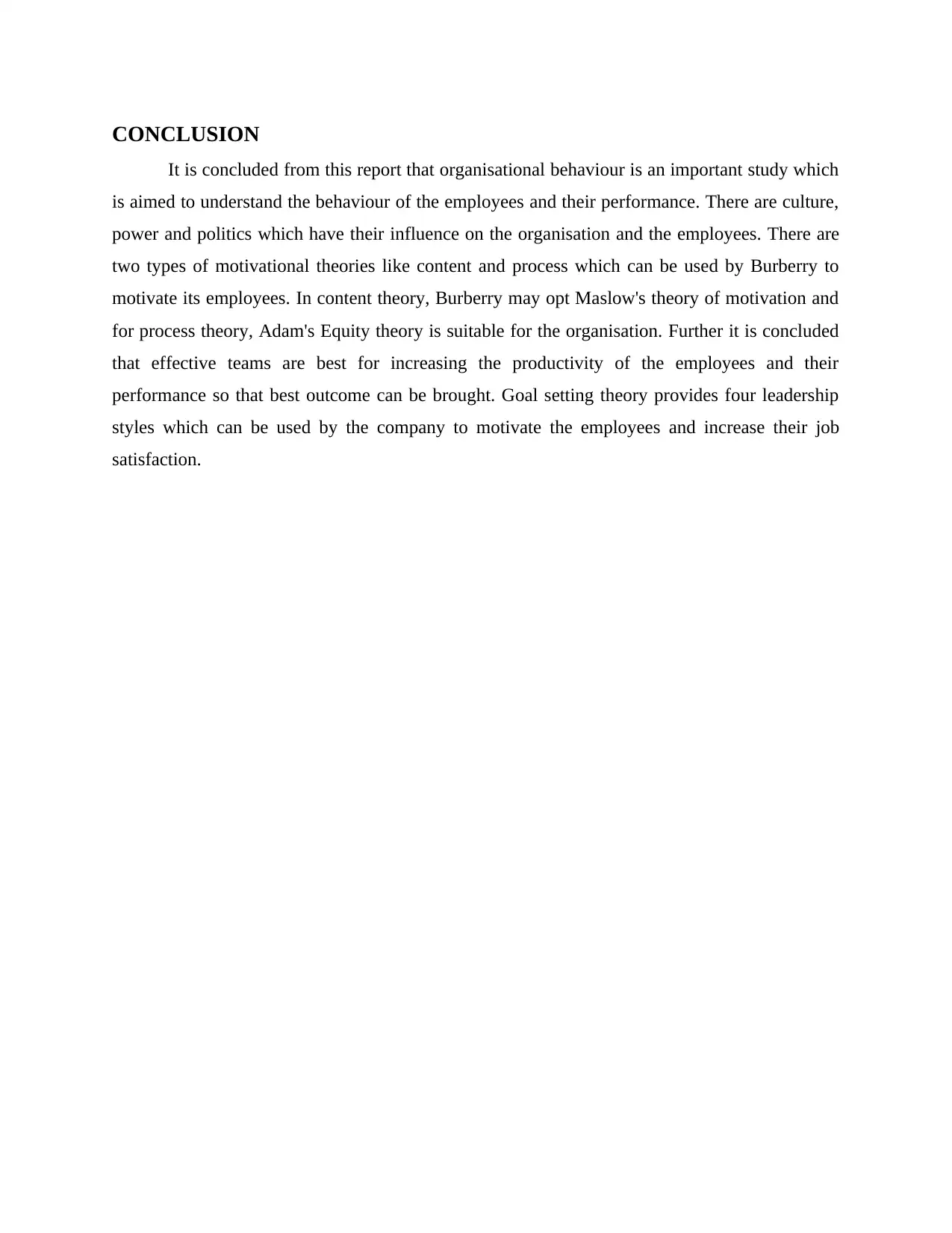
CONCLUSION
It is concluded from this report that organisational behaviour is an important study which
is aimed to understand the behaviour of the employees and their performance. There are culture,
power and politics which have their influence on the organisation and the employees. There are
two types of motivational theories like content and process which can be used by Burberry to
motivate its employees. In content theory, Burberry may opt Maslow's theory of motivation and
for process theory, Adam's Equity theory is suitable for the organisation. Further it is concluded
that effective teams are best for increasing the productivity of the employees and their
performance so that best outcome can be brought. Goal setting theory provides four leadership
styles which can be used by the company to motivate the employees and increase their job
satisfaction.
It is concluded from this report that organisational behaviour is an important study which
is aimed to understand the behaviour of the employees and their performance. There are culture,
power and politics which have their influence on the organisation and the employees. There are
two types of motivational theories like content and process which can be used by Burberry to
motivate its employees. In content theory, Burberry may opt Maslow's theory of motivation and
for process theory, Adam's Equity theory is suitable for the organisation. Further it is concluded
that effective teams are best for increasing the productivity of the employees and their
performance so that best outcome can be brought. Goal setting theory provides four leadership
styles which can be used by the company to motivate the employees and increase their job
satisfaction.
⊘ This is a preview!⊘
Do you want full access?
Subscribe today to unlock all pages.

Trusted by 1+ million students worldwide
1 out of 13
Related Documents
Your All-in-One AI-Powered Toolkit for Academic Success.
+13062052269
info@desklib.com
Available 24*7 on WhatsApp / Email
![[object Object]](/_next/static/media/star-bottom.7253800d.svg)
Unlock your academic potential
Copyright © 2020–2025 A2Z Services. All Rights Reserved. Developed and managed by ZUCOL.





